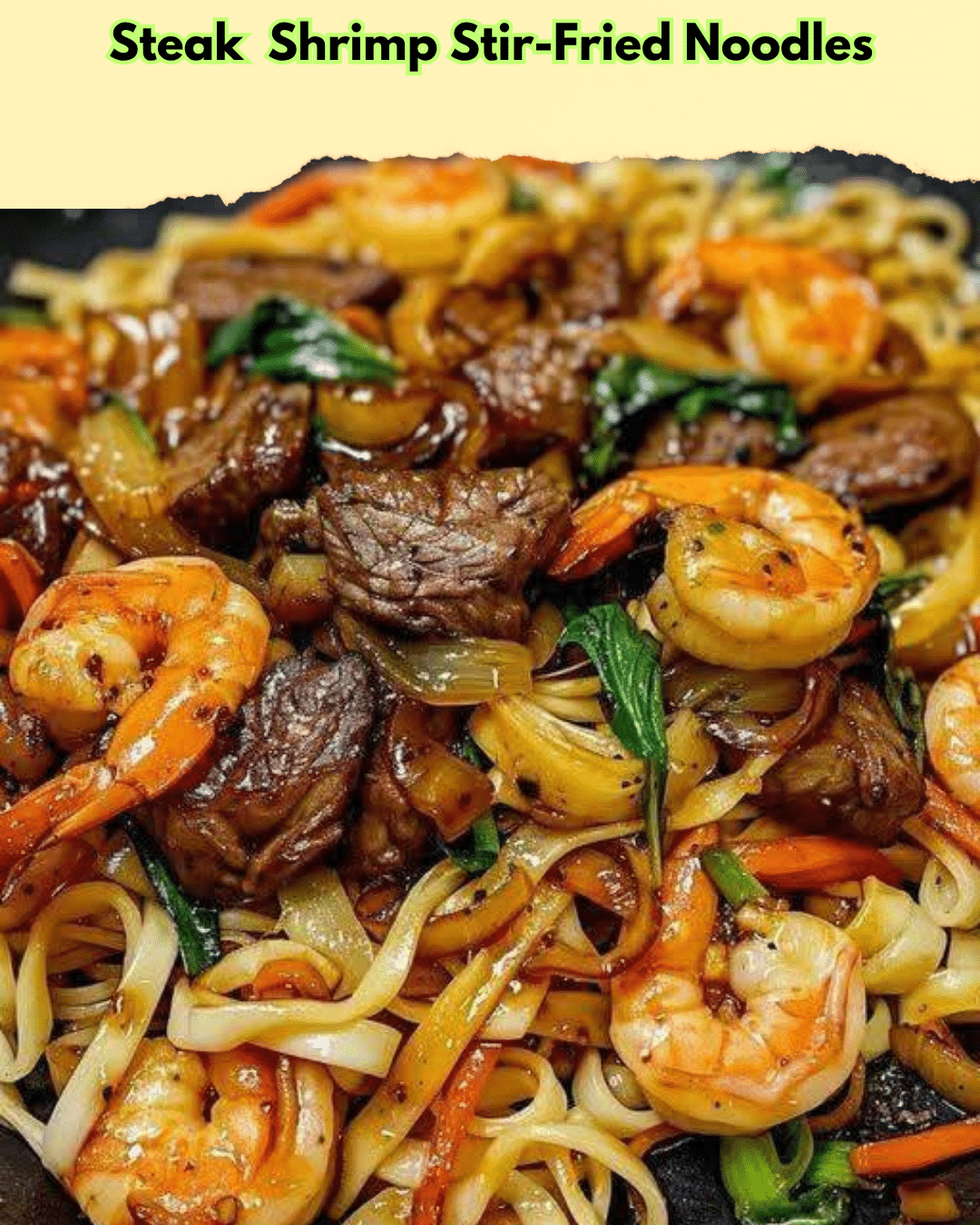Steak Shrimp Stir-Fried Noodles: A Perfect Balance of Flavor and Texture
This Steak Shrimp Stir-Fried Noodles recipe combines the richness of tender steak and succulent shrimp with a medley of vibrant vegetables and silky noodles to create a harmonious blend that will tantalize your taste buds. As the juicy steak and shrimp sizzle in the wok, they release a mouthwatering aroma that infuses with the garlicky and spicy undertones of our signature sauce. Perfect for a quick weeknight dinner or a special gathering, this dish offers a wholesome and flavorful experience that’s easy to prepare and a joy to savor.
Steak Shrimp Stir-Fried Noodles unite the best of both worlds: the deep, savory flavors of steak paired beautifully with the sweet, oceanic notes of shrimp. The ensemble is tied together with crisp stir-fried vegetables that add a welcome crunch and a burst of color, completing this vibrant, dish that is not only pleasing to the palate but also visually stunning.
Quick Recipe Highlights
- Flavor Profile: The dish features a savory and slightly sweet taste with a hint of umami, balancing well with the earthy undertones from the vegetables.
- Texture: Enjoy the delightful combination of tender steak, juicy shrimp, al dente noodles, and crispy vegetables.
- Aroma: Experience the enticing aroma of garlic and spices mingling with the rich scent of seared steak and seafood.
- Visual Appeal: This colorful plate is filled with golden-brown steak, pink shrimp, bright veggies, and glossy noodles.
- Skill Level Needed: Intermediate; this dish involves monitoring multiple elements simultaneously for perfect execution.
- Special Equipment: A wok or large skillet is ideal for achieving the high temperatures needed for a successful stir-fry.
Recipe Overview
- Difficulty Level: This recipe is categorized as medium difficulty due to the coordination required to manage different ingredients simultaneously without overcooking.
- Category: It fits well within family dinners or meal prep categories, providing versatility in serving occasions.
- Cuisine: Drawing from a fusion of Asian-inspired culinary traditions, this dish marries diverse textures and flavors harmoniously.
- Cost: Relatively moderate, with the primary expenses on quality steak and shrimp.
- Season: Best suited for the spring and summer months when fresh vegetables are at their peak.
- Occasion: Ideal for both casual dinners or special occasions, offering a sophisticated look and taste.
Why You’ll Love This Recipe
The Steak Shrimp Stir-Fried Noodles offer a medley of textures and flavors that make every bite a delight. The lusciousness of the steak contrasts beautifully with the delicate shrimp, offering a taste sensation that’s both satisfying and complex. This dish’s appeal lies in its ability to bring these different elements together seamlessly into a cohesive whole.
Convenience and simplicity are the central themes of this dish. With just a few easy steps, you can have a restaurant-quality meal on the table. Preparation is straightforward, with most time spent on chopping and marinating, while the actual cooking process is quick and rewarding.
Not only is this recipe delicious, but it’s also packed with proteins, vitamins, and minerals from the beef, shrimp, and vegetables. The varying ingredients offer a healthy macronutrient balance, giving you a meal that’s both satisfying and nutritious.
In a social setting, this dish is an absolute hit. It provides a vibrant visual presentation that catches everyone’s attention and serves as an excellent conversation starter at dinners or parties. The combination of diverse flavors invites friends and family to explore their taste preferences together.
From a thrift perspective, the recipe makes use of common pantry ingredients, and even premium items like steak and shrimp are used strategically to deliver luxury without breaking your budget. Whether you are a seasoned chef or a kitchen novice, the combination of cost-efficiency and flavor makes this recipe an attractive option.
Historical Background and Cultural Significance
Steak and shrimp have rich, diverse histories that span the globe, and this dish captures elements of both. The pairing represents an age-old appreciation for surf and turf, a concept that combines the bounty of the land with treasures of the sea. Dating back to coastal and pastoral societies, this culinary union celebrates the varied resources nature offers.
The cultural fusion present in this dish embodies a modern approach to global cuisine, where traditional Asian stir-fry techniques meet Western ingredients like beef steak. It’s an illustration of culinary globalization, where the accessibility and exchange of ingredients influence contemporary cooking styles and meal choices.
Over time, stir-fries have evolved to include a plethora of ingredients and styles, with each region adding its unique twist. This recipe adapts the concept by bringing together textural variety in a way that respects regional traditions while crafting something novel and exciting.
Numerous regional variations of stir-fry recipes exist, each incorporating local spices, herbs, or proteins, showcasing ingenuity in blending available resources with cultural tastes. By introducing steak and shrimp, this recipe highlights a spectrum of flavors and cooking traditions that make each version uniquely special.
Ingredient Deep Dive
Beef Steak: Beef has long held a place of honor in many cuisines, signifying prosperity and heartiness. Side cut or sirloin are excellent options for this dish. These cuts provide a balance between tenderness and taste, absorbing flavors without becoming overly chewy.
Nutritionally, beef offers substantial protein alongside vital nutrients like iron and vitamin B-12. It’s essential to select beef with a deep brown-red color and a bit of marbling for flavor. Be sure to store it at a consistent low temperature to retain quality. If a substitution is needed, consider chicken or tofu to balance the flavors in the dish.
Shrimp: Seafood and particularly shrimp, have been staples in many coastal communities’ diets due to their availability and rich flavors. In this dish, shrimp adds both a luxurious texture and a subtle sweetness that elevates the overall taste experience.
Nutritionally, shrimp is a powerhouse of lean protein and minerals such as iodine and selenium, promoting a range of health benefits. Look for firm, translucent shrimp when selecting fresh options. Store them on ice or in a chilly part of the fridge to ensure freshness. For variations, scallops or chunks of white fish can stand in as suitable alternatives.
Common Mistakes to Avoid
- Avoid overcrowding the pan to ensure even cooking and prevent steaming instead of searing.
- Don’t overcook the shrimp or steak; doing so will result in tough textures. Shrimp should turn pink and steak should remain a bit bouncy to touch.
- Make sure your pan or wok is hot before adding the ingredients to achieve a quick sear and maintain crispness.
- Monitor salt levels; both steak and shrimp are naturally savory, so adding too much extra salt can overpower delicate flavors.
- Cook the vegetables just to crisp-tenderness; overcooked veggies will lose both color and nutrients.
- Be cautious not to add too much sauce, which can result in soggy noodles and dilute the flavors of your dish.
- Failing to marinate the beef properly can lead to a less flavorful result, so allocate time for this step.
- Ensure to drain excess moisture from shrimp and beef before stir-frying to prevent boiling.
- Using regular noodles instead of fresh or pre-soaked ones could result in uneven cooking.
- Forgetting to slice the steak and vegetables uniformly can lead to uneven cooking times and texture.
Essential Techniques
Stir-Frying: Mastering stir-frying is crucial for achieving an authentic texture. This high-heat, quick-cooking technique enhances the freshness and flavor concentration of the dish. To excel, practice constant motion when stirring ingredients, ensuring everything cooks evenly without lingering.
Proper Knife Skills: Precision chopping maintains uniformity and ensures even cooking, particularly important for ingredients with different natural cooking times. Learn to employ a sharp knife to cut steak thinly against the grain and vegetables into similar-sized pieces. This ensures aesthetic harmony and even heating.
Sauce Emulsification: A well-mixed sauce can make or break a stir-fry. You want a balanced consistency that clings to the noodles without overwhelming them. Emulsify by adding sauce ingredients gradually, allowing them to blend naturally with the hot pan, ensuring flavors coat ingredients evenly.
Marinade Mastery: Marinating the beef infuses it with flavor and tenderness. Allow adequate time for marination so that the acid and spices have ample opportunity to tenderize and flavor the meat. Avoid over-marinating, as this can break down fibers and result in a mushy texture.
Pro Tips for Perfect Steak Shrimp Stir-Fried Noodles
Practice patience when heating your pan or wok until it reaches its optimum temperature; this helps sear meat and vegetables perfectly.
Marinate your steak for a minimum of 30 minutes to deepen its flavor profile, using a mix of soy sauce, garlic, and a dash of honey.
Try using different noodle varieties such as rice noodles or chow mein, allowing them to soak up flavors uniquely while providing distinct textures.
Experiment with adding a touch of sesame oil at the end of cooking to impart a delicate aroma and deepen flavor complexity.
Avoid adding all the sauce at once; instead, drizzle gradually, as this helps maintain texture integrity of noodles and veggies.
Consider blanching harder vegetables like broccoli beforehand to ensure they cook even and retain vibrancy once introduced to the stir-fry.
Always keep ingredients dry before cooking to achieve a proper sear without the risk of steaming.
Use a high-smoke-point oil, such as grapeseed or peanut oil, for better heat retention and improved stir-fry results.
Variations and Adaptations
Regional Variations: In different parts of Asia, stir-fried noodles adopt unique changes like incorporating local herbs such as Thai basil or using fermented ingredients like Korean gochujang for added depth.
Seasonal Adaptations: Introduce seasonal produce like asparagus or sugar snap peas in spring for a fresh note, or root vegetables like carrots and turnips in autumn to enrich the hearty, earthy aspects.
Dietary Modifications: Transform this dish to suit dietary needs, such as using gluten-free soy sauce and rice noodles for gluten allergies or tofu and additional vegetables for a complete vegetarian version.
Flavor Variations: Spice up your noodles with chili flakes or Sriracha for heat, or tweak sweetness with a dash of pineapple bits, blending contrasting piquant and sweet notes.
Texture Modifications: For altered textures, include nuts like cashews or sliced water chestnuts for an unexpected crunch, enhancing variety in each bite.
Presentation Alternatives: Elevate your plating by twirling noodles high for an artistic finish, or place tidily in bowls for easy, single-serve options that enhance the dish’s visual appeal.
Serving and Presentation Guide
For a classic touch, serve the stir-fried noodles in traditional shallow bowls or wide plates that allow for easy access and presentation of all elements.
To garnish, finely chop scallions and sprinkle them over the dish, adding a chiming freshness or scatter freshly minced cilantro for a burst of herbaceous vibrancy.
Classic stir-fried noodle accompaniments in meals often include sides like pickled green papaya or a light soup, complementing the hearty main dish.
Offering a modern twist, consider providing guests with small dipping bowls of chili paste or soy-based sauces, creating a personalized flavor profile.
Temperature considerations are important; the dish should be served promptly, warm to maintain its texture and aromatic fragrances.
For portion control, consider smaller servings alongside mixed greens or cucumber salads, ensuring a wholesome, balanced meal approach.
Wine and Beverage Pairing
Choose light white wines like Chardonnay or Riesling to complement the seafood tones and allow the complex flavors of the stir-fried noodles to shine.
For those who prefer non-alcoholic alternatives, jasmine tea or ginger-infused cold brew tea provide refreshing pairings that balance rich and spicy notes.
Explore light Asian lagers or crisp sours if beer accompanies the meal, offering a hoppy balance that accentuates the savory components.
Consider chilled green tea for a subtle, earthy contrast or iced lemongrass tea for enhanced aromatics alongside the dish.
When serving temperature matters, white wines and teas should be served cold, while beer performs well chilled or slightly above.
Ensure beverages are served in appropriate glassware, enhancing the dining experience whether it’s wine glasses or traditional teacups.
Storage and Shelf Life
Store leftovers in an airtight container within the refrigerator, keeping them fresh for up to 3 days. Always allow the dish to cool completely before sealing to prevent condensation.
Maintain a consistent refrigerator temperature under 40°F (4°C) to slow bacterial growth, ensuring safety and longevity of stored food.
Using glass or BPA-free containers helps maintain flavor and moisture better compared to standard plastic cartons, offering an ecological bonus.
Signs of spoilage include off odors, sticky textures, or visible mold, all indicating the need for disposal.
Reheat leftovers gently in a skillet over medium heat or in the microwave, stirring occasionally to ensure even warmth.
For freezing, package portions in suitable freezer-safe containers for up to 1 month, then thaw in the fridge before reheating.
Make Ahead Strategies
Prepare ingredients like vegetables and marinate the steak up to 24 hours in advance, keeping them appropriately chilled until ready to cook.
For efficient storage between prep stages, use resealable bags or labeled containers to separate components like sauces and proteins.
Consider the potential quality impact of light reheating on the finished product, ensuring focus on maintaining tenderness and moisture.
When assembling pre-cooked elements, maintain order to slice steak and shrimp while fresh, refreshing the dish with a splash of fresh sauce or herbs.
Reheat cautiously to avoid a texture breakdown, ensuring no part of the dish becomes too soft or rubbery.
Add fresh elements like crisp vegetables or chilled sauces just before serving to enliven reheated portions.
Scaling Instructions
Scaling recipes successfully comes down to proportional adjustments; for halving, ensure changes reflect ingredient masses and sauces equally to maintain intensity and balance.
Doubling or tripling requires larger pans or increments in cooking time; avoid overcrowding ingredients to preserve the original consistency and flavor balance.
When increasing portion size, allocate ample utensils, thorough mixing and frequent pan shaking to guarantee uniformity.
Timing modifications include patience in allowing stovetops to return to initial temperature settings post-additional portions to even heat distribution for newly incorporated elements.
Evaluate additional storage space requirements to accommodate increased yield, ensuring appropriate segmented storage is utilized.
Nutritional Deep Dive
The richness of the Steak Shrimp Stir-Fried Noodles begins with its nutritious macro balance, providing ample protein from both steak and shrimp.
With a carbohydrate base from the noodles and fiber contributions from the vegetables, the dish adheres to fundamental food group distribution ensuring a full meal offering.
Evaluate micronutrients for enhanced health promotion with essential minerals, such as iron and B-complex vitamins from the beef, playing key roles in cellular growth and energy metabolism.
Despite the richness, the dish can complement weight management goals through portion control and substituting lower-calorie noodles or increasing vegetable content for volume without added calories.
Dietary considerations should be aligned with personal health requirements, implementing allergen-conscious variants where necessary.
A thoughtful portion analysis entails balancing protein, carbohydrates, and fats, considering development goals and lifestyle needs.
Dietary Adaptations
For a gluten-free version, adapt by using tamari instead of soy sauce and substitute traditional wheat noodles with gluten-free alternatives, ensuring a safe, inclusive meal.
Accommodating dairy-free eating entails maintaining existing ingredients; this recipe naturally aligns with such requirements without modification.
To create a vegan alternative, swap out animal proteins for seasoned tofu and adjust sauces to incorporate more plant-based umami flavors.
Aiming for a low-carb meal can include substituting zucchini or shirataki noodles in place of traditional wheat varieties, offering that same satisfying texture without carb burden.
For keto-friendly considerations, limit sugars in any sauces and opt for lean cuts of beef while indulging in protein-rich shrimp as principal elements.
Incorporate paleo preferences by focusing primarily on whole, unprocessed proteins, vegetable inclusions, and herbs for seasoning, promoting healthier options supporting lifestyle goals.
Personalized meal preferences like low-FODMAP or specific allergens can necessitate targeted ingredient swap-out, improving accessibility for various nutritional needs.
Troubleshooting Guide
Avoid texture issues by vigilantly monitoring cooking temperatures and times, ensuring ingredient readiness aligns collectively for a harmonious balance free from mushiness.
Balance flavor by taste-testing sauces throughout preparation, adhering to guided portions for a sweet-savory equilibrium, avoiding overpowering a single flavor profile.
Temperature control equates to consistency; regulate frying elements on high heat, allowing short, intense applications for all included items, maintaining consistency in surface cooking.
Rely on proper equipment and assess kitchen tools’ appropriateness like a sharp knife for precise cuts and a sturdy, wide-bottomed pan to ensure even heat conductance.
For ingredient substitution, deliberate flavor impact for an equal exchange, selecting likely alignments for protein switches or altered noodle types without diet compromise.
Overcome timing conflicts by developing a pre-cook preparatory checklist, ensuring a steady flow throughout assembly and execution prevents delays.
Recipe Success Stories
The community’s engagement with the Steak Shrimp Stir-Fried Noodles has featured varied enthusiastic feedback, lauding the rich taste and ease of preparation, perfecting meal comfort.
Reader adaptations expanded upon by community members shared regional spice incorporations, yielding delightful flavor duality and opening broader culinary questioning.
Success stories submitted by home chefs invested in technique mastery illustrate warmly detailed accounts of flavor depth exploration in home kitchens and shared satisfaction.
Enthusiastic photographer submissions highlight colorful plating acumen, contributing to the visual inspiration becoming equally motivating entry points to broader DIY cooking passion.
The sharing of adaptation advice, trial stories, demonstrating personal recipe relationships cultivates dynamic input in nurturing an evolved food-loving community.
Frequently Asked Questions
Choose cuts like flank, ribeye, or sirloin, which are tender yet flavorful. Slice thinly against the grain for optimal texture.
How do I adjust the dish for extra spice?
Incorporate chili flakes, fresh chopped chilies, or a drizzle of hot sauce to the finished plate to achieve your desired heat level.
Can I use frozen shrimp?
Yes, ensure they are fully thawed and patted dry before cooking to prevent excess water content, which can cause steaming.
What is the best substitute for noodles?
Zucchini noodles are a healthy, low-carb alternative, or rice noodles for a gluten-free option maintaining a similar texture.
Is it essential to marinate the beef?
Marinating is recommended for additional flavor but can be omitted if time-constrained. Just ensure the beef is well-seasoned.
What oils are best for high-heat cooking?
Opt for oils with high smoke points such as canola, grapeseed, or peanut oils to maintain flavor integrity without burning.
How can I prevent the dish from becoming too salty?
Be mindful of the soy sauce quantity and balance it with unsalted broth or fresh spices, tasting as you proceed to adjust.
Are there any specific vegetables that pair best?
Bok choy, bell peppers, and snow peas are excellent partners, contributing vibrant color and crunch to the dish structure.
What should the final texture of the shrimp be?
Aim for shrimp to appear opaque with a slight pink hue, turning firm to the touch without rubberiness, indicative of correct cooking.
Can I substitute chicken for beef?
Yes, chicken breast or thigh pieces can be utilized, similarly marinated, and cooked to maintain uniform flavor infusion.
Additional Resources
For further exploration into this fusion of Asian-inspired and surf-and-turf techniques, peruse related beef or seafood stir-fry recipes that highlight different flavor pairings.
Technique guides focusing on stir-fry essentials reveal step-by-step strategies to elevate this recipe success while ensuring bursting flavors with precise timing.
Equip your kitchen effectively with tool recommendations specifically designed for stir-fry excellence, from non-stick pans to multi-tool spatulas aiding in optimum results.
Investigate nuanced flavor profiles through diverse ingredient analysis, understanding different soy sauces, aromatic infusions, and productive spice combinations.
Explore seasonal adaptations, guiding your ingredient choices and recipes to ensure fresh produce application selects tailored for each cultural influence represented in the recipe.
Print
Steak Shrimp Stir-Fried Noodles
Description
A savory blend of tender steak, succulent shrimp, and stir-fried noodles with vegetables and a tangy soy-based sauce.
Ingredients
For the Crust:
- 8 oz flank steak, thinly sliced
- 8 oz shrimp, peeled and deveined
- 12 oz stir-fry noodles
- 2 tablespoons vegetable oil
- 1 cup bell pepper, sliced
- 1 cup snap peas
- 3 tablespoons soy sauce
Instructions
1. Prepare the Crust:
- Cook the noodles according to package instructions and set aside.
- Heat 1 tablespoon of vegetable oil in a large skillet over medium-high heat. Add the steak slices and cook until browned, about 3 minutes. Remove from skillet.
- In the same skillet, add the remaining oil and shrimp. Cook until the shrimp are pink and opaque, about 2 minutes. Remove from skillet.
- Add bell peppers and snap peas to the skillet, stir-frying for 2-3 minutes until tender-crisp.
- Return steak, shrimp, and cooked noodles to the skillet. Pour soy sauce over the mixture and toss to combine. Cook for 2 more minutes to heat through.
Notes
You can customize the seasonings to taste.




